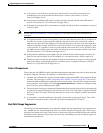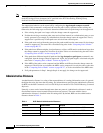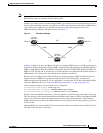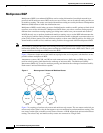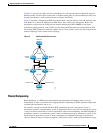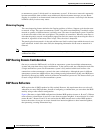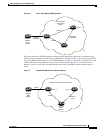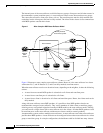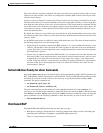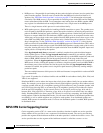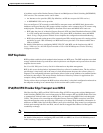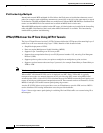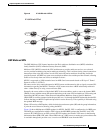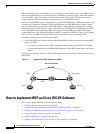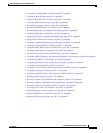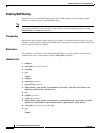
Implementing BGP on Cisco IOS XR Software
Information About Implementing BGP on Cisco IOS XR Software
RC-37
Cisco IOS XR Routing Configuration Guide
OL-14356-01
Each route reflector would be configured with other route reflectors as nonclient peers (thus, all route
reflectors are fully meshed). The clients are configured to maintain iBGP sessions with only the route
reflector in their cluster.
Usually, a cluster of clients has a single route reflector. In that case, the cluster is identified by the router
ID of the route reflector. To increase redundancy and avoid a single point of failure, a cluster might have
more than one route reflector. In this case, all route reflectors in the cluster must be configured with the
cluster ID so that a route reflector can recognize updates from route reflectors in the same cluster. All
route reflectors serving a cluster should be fully meshed and all of them should have identical sets of
client and nonclient peers.
By default, the clients of a route reflector are not required to be fully meshed and the routes from a client
are reflected to other clients. However, if the clients are fully meshed, the route reflector need not reflect
routes to clients.
As the iBGP learned routes are reflected, routing information may loop. The route reflector model has
the following mechanisms to avoid routing loops:
• Originator ID is an optional, nontransitive BGP attribute. It is a 4-byte attributed created by a route
reflector. The attribute carries the router ID of the originator of the route in the local autonomous
system. Therefore, if a misconfiguration causes routing information to come back to the originator,
the information is ignored.
• Cluster-list is an optional, nontransitive BGP attribute. It is a sequence of cluster IDs that the route
has passed. When a route reflector reflects a route from its clients to nonclient peers, and vice versa,
it appends the local cluster ID to the cluster-list. If the cluster-list is empty, a new cluster-list is
created. Using this attribute, a route reflector can identify if routing information is looped back to
the same cluster due to misconfiguration. If the local cluster ID is found in the cluster-list, the
advertisement is ignored.
Default Address Family for show Commands
Most of the show commands provide address family (AFI) and subaddress family (SAFI) arguments (see
RFC 1700 and RFC 2858 for information on AFI and SAFI). The Cisco IOS XR software parser provides
the ability to set the afi and safi so that it is not necessary to specify them while running a show
command. The parser commands are:
• set default-afi {ipv4 | ipv6 | all}
• set default-safi {unicast | multicast | all}
The parser automatically sets the default afi value to ipv4 and default safi value to unicast. It is
necessary to use only the parser commands to change the default afi value from ipv4 or default safi value
from unicast. Any afi or safi keyword specified in a show command overrides the values set using the
parser commands. Use the following command to check the currently set value of the afi and safi:
• show default-afi-safi-vrf
Distributed BGP
Distributed BGP splits BGP functionality into three process types:
• BGP process manager—Responsible for verifying configuration changes and for calculating and
publishing the distribution of neighbors among BGP speaker processes.
There is a single instance of this process.



